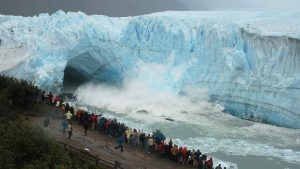Growing concern over the Perito Moreno Glacier, one of the most emblematic on the planet, is under scientific scrutiny. Two images taken by the European satellite Sentinel-2, with a little over three months difference —between January and April 2025—, show a marked retreat in its front.
The comparison was made by Dr. Xabier Blanch, from the Universitat Politècnica de Catalunya, and shared on social media. Blanch, an expert in glaciological monitoring, warns that it is not appropriate to interpret these changes as a definitive loss.
Like other ice bodies, the glacier experiences seasonal movements, and to establish a specific retreat, images from consecutive years in the same season should be compared. Nevertheless, the visible variations reflect a changing dynamic that deserves to be analyzed more deeply.

A plan to measure glacier melting
With this goal in mind, Blanch leads a multidisciplinary team of engineers and researchers from Spain, Germany, and Colombia, who have been carrying out an ambitious monitoring project on the glacier since last summer. They installed eight high-resolution cameras on a rocky promontory located 215 meters from the glacier front to record images of the area every 30 minutes.
These photographs will be used to build three-dimensional models using artificial intelligence, which will allow for accurately calculating the daily volumes of ice calving, a phenomenon known as calving. In this way, they aim to establish a real-time monitoring system that provides specific data on the glacier’s evolution and the effects of climate change on one of the natural gems of Patagonia.

Perito Moreno Glacier will undergo a drastic retreat if it loses contact with the peninsula
The Perito Moreno Glacier, one of Argentina’s most emblematic natural wonders, faces a worrying threat. According to a report from the Glaciarium glaciological center, if current conditions persist, the glacier could disconnect from the Magallanes Peninsula and enter an irreversible retreat phase.
The report is based on data collected by the GPM Station, a meteorological station located on the southern margin of the Perito Moreno Glacier since 1995. These data show a constant increase in atmospheric temperature in the region over the past 28 years.
“It already has 28 years of data, which show evidence of atmospheric warming in the region,” the report indicates. It is highlighted that the average annual temperature has increased by 0.8°C during this period, and summers have experienced a significant increase in maximum temperatures.

